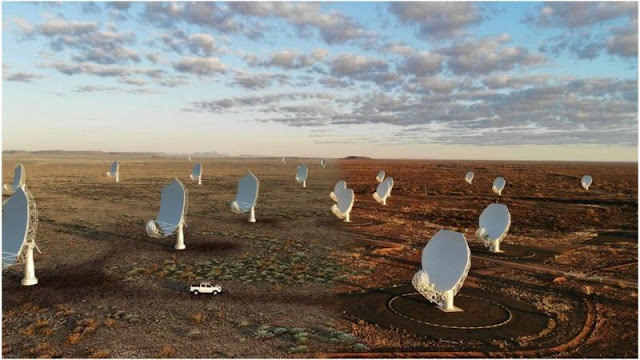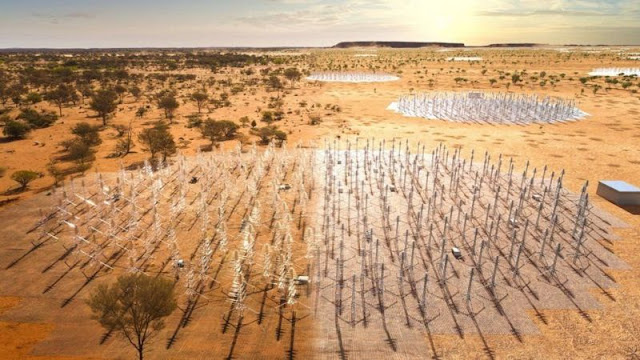Art made in South Africa: This telescope is being hailed as the greatest project of the 21st century.
Work has begun on one of the greatest scientific projects of the 21st century.
The first meeting of the council of the Square Kilometer Array Observatory has approved the implementation of the project, which will build the world's largest telescope in the next ten years.
The member states have approved a 1,000-page document that covers other issues, including opening bank accounts to hire industrial contractors.
Many radio receivers will be installed in the square kilometer array (SKA) telescope. These radio receivers will be installed from South Africa to Australia.
Attached to a state-of-the-art computer, this high-resolution telescope will help astronomers solve some of the most fundamental questions of astrophysics.
How did the first star in the universe start shining? After all, what is 'dark energy'? The mysterious kind of energy that is moving galaxies away from each other due to the increasing gravity. And the most basic question is, are we alone in the universe? This SKA telescope will be extraordinarily sensitive and will be able to record any type of transmission in space.
The new international agreement under which the observatory is being set up was finalized last month. The agreement led to the council's first meeting to be held online due to the Code 19 epidemic. The project had been under construction for 30 years and the meeting was called for its final approval.
"I think this council meeting actually heralded the birth of this observatory," said Professor Bill Diamond, the first director general of the Square Kilometer Array Observatory.
The Observatory is headquartered in Jordale Bank, UK
Speaking to BBC News, Professor Bill Diamond added: "Following the ratification of this international agreement by the UK on 15 January, we have become a legal entity, but even at this stage it is like an empty vessel. Was Work has begun since the first meeting of the council and the vessel is now filling up.
The council meeting approved policy, rules and regulations that would make the observatory a reality.
Now the next important step is to build this telescope. Tenders are expected to be issued in July this year and the groundbreaking ceremony will be held by the end of this year.
The observatory will be located in a remote and uninhabited area in the northern part of South Africa, in Caro and in Western Australia, in Murchison.
In addition to parabolic antennas and dishes, the telescope will also have dipole antennas that look similar to conventional antennas. The goal is to build a sensitive fence that covers hundreds of thousands of square miles.
Artwork made in Western Australia: SKA will take seven to eight years to build
The system will operate at frequencies ranging from 50 MHz to 25 GHz. This 'wavelength' will be from a few centimeters to several meters.
The telescope, which will be made extraordinarily sensitive, will also be able to pick up very light signals coming from galaxies billions of light-years from Earth, including signals that make up the 'Big Bang' or system. Born a few hundred million years after the solar system came into being.
"We are entering an age where a giant telescope will try to unravel the mysteries of this universe," said Dr. Katherine Caesarski, head of the SKAO Council.
He said that behind all this is the hard work of many people spread all over the world.
Dr Leah Morabito, a professor at the University of Durham in the UK and a member of the British SKA's Science Committee, said: It is very encouraging then that we will be able to draw our attention to the bright future of SKA.
The council met on Wednesday and Thursday under the chairmanship of the countries that have ratified the SKA agreement, including Australia and South Africa.
Canada, China, France, Germany, India, Japan, South Korea, Spain, Sweden and Switzerland were also present at the meeting. All of these countries attended the meeting as observers because the parliamentary bodies of these countries have not yet completed the process of ratifying the international agreement. It is hoped that all these countries will ratify this agreement soon.
The telescope is estimated to cost چار 2.4 billion over the next ten years to build and operate.
Professor Diamond said: "They estimate that it will take seven to eight years to build, with an 18-month period for possible delays. In which all these projects will be completed.
"Because there will be a lot of dishes in the interferometer, and once some of these dishes are fitted, hopefully some scientific work will start because scientists are reluctant to use it," he added. '
Like many other space observatories, SKA has expressed concern about plans to launch a large number of communications planets into space.
Telescopes designed to observe space block communication planets and leave a line of light in its field.
For SKA radio telescopes, communications from planets can cause single disruptions to Earth.
Professor Diamond says he is pleased that satellite companies are taking an interest in the work.
These companies include SpaceX, which has about 1,000 spacecraft in orbit, and OneWeb, which will have about 500 spacecraft in space in a year and a half.

















No comments: